Ruby on Rails PDF Generation with Prawn: Complete Tutorial
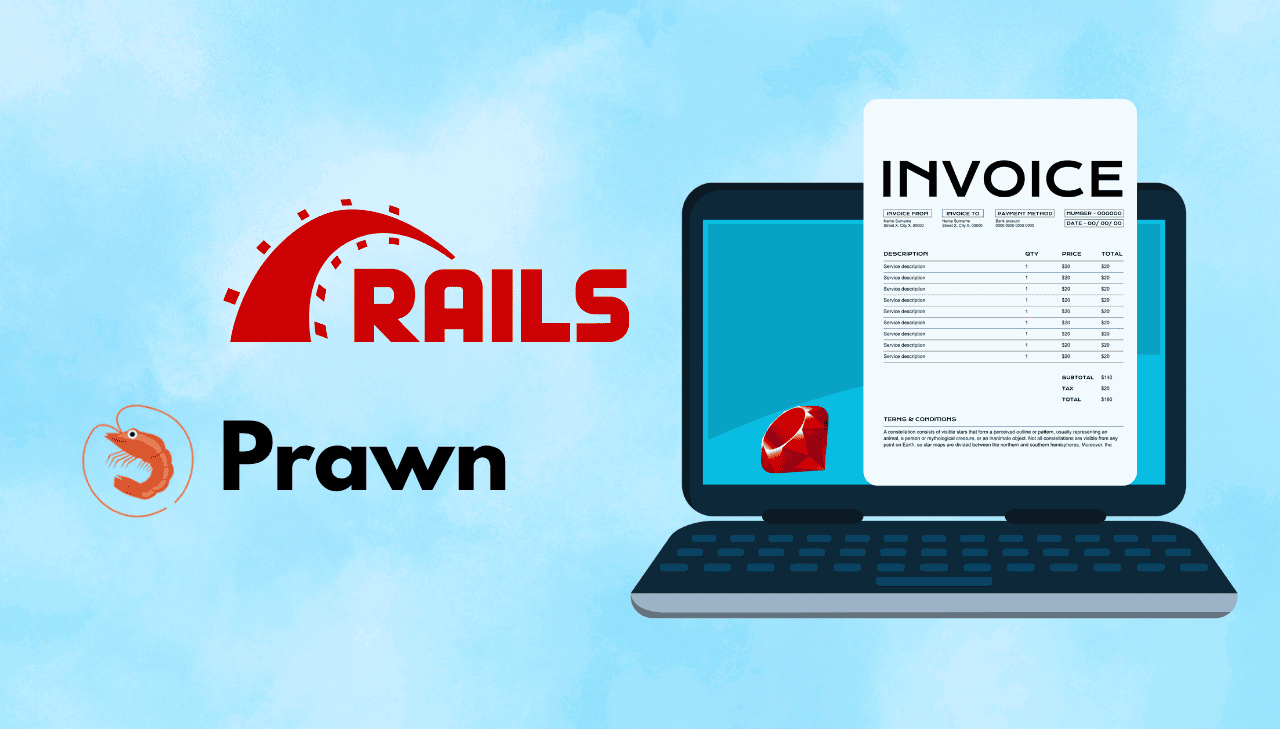
For Ruby on Rails developers, the ability to programmatically generate professional PDF documents is essential for many web applications. Prawn is one of the most popular Ruby gems that makes creating complex, beautiful PDFs straightforward and enjoyable. This comprehensive guide shows how Prawn transforms complex PDF generation into an elegant, Ruby-like experience through its intuitive API and powerful layout capabilities.
What is Prawn PDF Library?
Prawn is a pure Ruby library for PDF document generation. Unlike many alternatives that rely on external dependencies or HTML to PDF conversion, Prawn provides a native Ruby API for creating PDFs from scratch. It offers precise control over layout, typography, and design while maintaining Ruby's intuitive syntax.
Key Features and Capabilities
Prawn offers a comprehensive set of features that make it a popular choice for PDF generation in Ruby applications:
- Layout system with precise positioning and grid support.
- Rich text formatting with extensive typography control.
- Table generation with advanced styling (via prawn-table gem).
- Vector graphics and shape drawing capabilities.
- Image embedding with PNG and JPEG support.
- Multi-page documents with automatic pagination.
- Custom fonts and comprehensive Unicode support.
- Prawn is designed for programmatic PDF creation, not HTML to PDF conversion. It works by building PDF documents through Ruby code rather than rendering HTML content.
- If you need to convert HTML to PDF, consider dedicated solutions. See HTML to PDF Conversion Options for recommendations.
Getting Started with Prawn in Ruby on Rails
Let's integrate Prawn into your Rails application. In this section, we'll cover how to install it and create our first PDF document.
Installation
Add Prawn to your Rails application by including it in your Gemfile:
gem 'prawn'
Then run bundle install:
bundle install
For additional functionality, you may also want to add:
gem 'prawn-table' # For table functionality
gem 'prawn-svg' # For SVG support
Our First PDF Document
Let's create a simple PDF generator in Rails – app/controllers/pdfs_controller.rb:
class PdfsController < ApplicationController
def generate
pdf = Prawn::Document.new
pdf.text "Document Generated Successfully!", size: 30, style: :bold
pdf.move_down 20
pdf.text "This document demonstrates basic PDF generation with Prawn.", size: 18
send_data pdf.render,
filename: "sample_document.pdf",
type: "application/pdf",
disposition: "inline"
end
end
Add the route:
# config/routes.rb
Rails.application.routes.draw do
get 'generate_pdf', to: 'pdfs#generate'
end
This basic example creates a PDF with text and serves it directly to the browser:
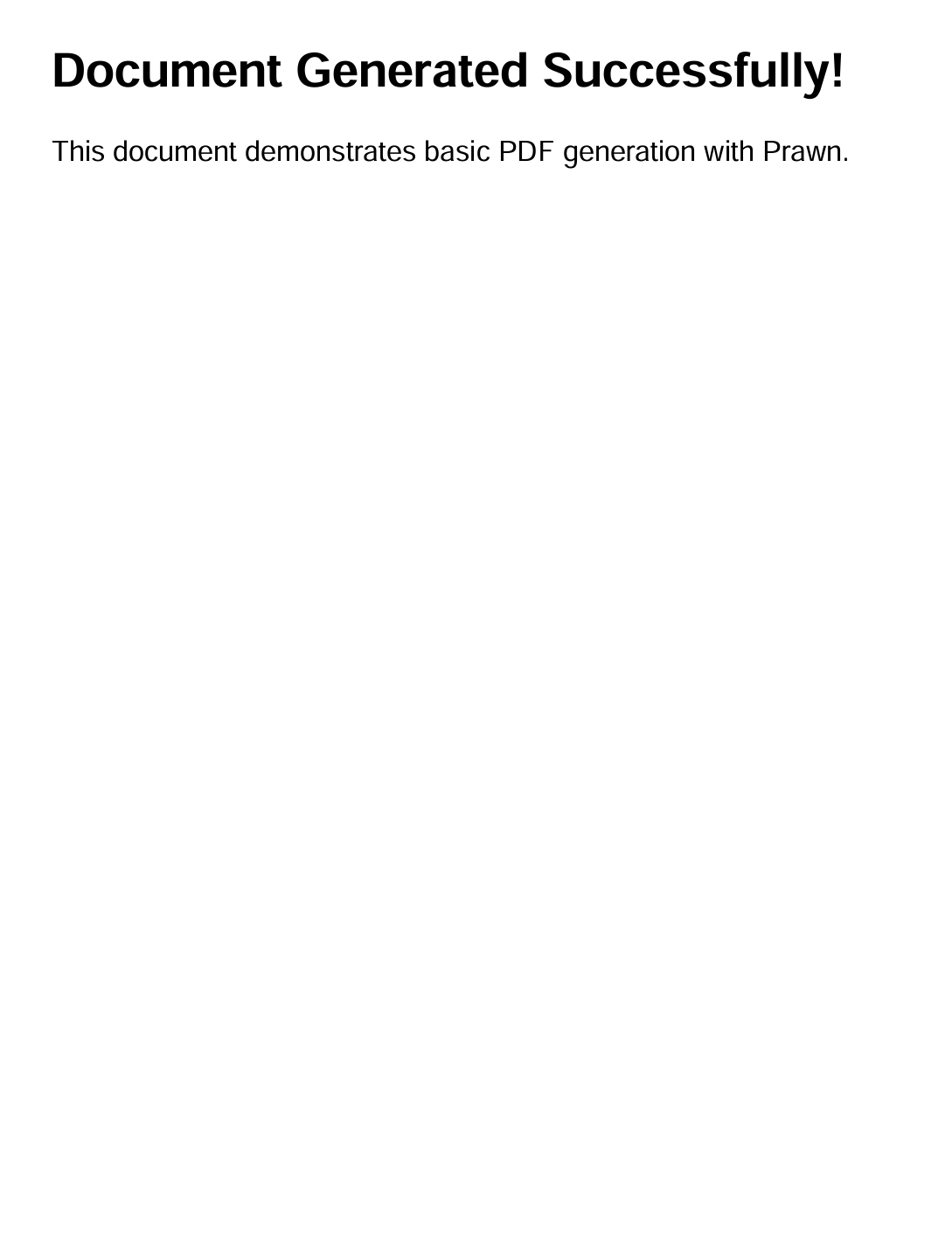
Working with Text in PDFs Using Prawn
Prawn provides extensive text formatting capabilities that allow you to create professional-looking documents with rich typography.
Text Styling and Formatting
The following example showcases the wide range of text formatting options available in Prawn, including fonts, colors, alignment, and spacing.
# app/controllers/pdfs_controller.rb
class PdfsController < ApplicationController
def generate
pdf = Prawn::Document.new do |pdf|
# Page title
pdf.text "Text Formatting with Prawn", size: 24, style: :bold, align: :center
pdf.move_down 30
# Different font sizes
pdf.text "Large text", size: 24
pdf.text "Medium text", size: 18
pdf.text "Small text", size: 10
pdf.move_down 25
# Font styles
pdf.text "Bold text", style: :bold
pdf.text "Italic text", style: :italic
pdf.move_down 25
# Text alignment
pdf.text "Left aligned text", align: :left
pdf.text "Center aligned text", align: :center
pdf.text "Right aligned text", align: :right
pdf.text "Justified text. Justified text. Justified text. Justified text. Justified text. Justified text. Justified text. Justified text. Justified text.", align: :justify
pdf.move_down 25
# Colors - use hex codes without # symbol
pdf.fill_color "FF0000" # Red
pdf.text "Red text"
pdf.fill_color "0000FF" # Blue
pdf.text "Blue text"
pdf.fill_color "000000" # Back to black
pdf.move_down 25
# Leading (line spacing)
pdf.text "Text with custom leading", leading: 5
# Character spacing
pdf.text "Spaced out text", character_spacing: 2
end
send_data pdf.render,
filename: "styled_text.pdf",
type: "application/pdf",
disposition: "inline"
end
end
Here's the output:

Working with Different Fonts
Prawn supports both built-in PDF fonts and custom fonts. This example demonstrates how to use various font families and styles in your documents.
# app/controllers/pdfs_controller.rb
class PdfsController < ApplicationController
def generate
pdf = Prawn::Document.new do |pdf|
# Page title
pdf.text "Font Examples with Prawn", size: 24, style: :bold, align: :center
pdf.move_down 30
# Built-in fonts
pdf.font "Helvetica"
pdf.text "Helvetica font (default)", size: 14
pdf.move_down 10
pdf.font "Times-Roman"
pdf.text "Times Roman font", size: 14
pdf.move_down 10
pdf.font "Courier"
pdf.text "Courier font (monospace)", size: 14
pdf.move_down 25
# Custom fonts (if available)
begin
pdf.font_families.update(
"AveriaLibre" => {
normal: Rails.root.join("app/assets/fonts/AveriaLibre-Regular.ttf"),
bold: Rails.root.join("app/assets/fonts/AveriaLibre-Bold.ttf"),
italic: Rails.root.join("app/assets/fonts/AveriaLibre-Italic.ttf"),
}
)
pdf.font "AveriaLibre"
pdf.text "Custom AveriaLibre regular", size: 16
pdf.move_down 10
pdf.text "Custom AveriaLibre bold", size: 16, style: :bold
pdf.move_down 10
pdf.text "Custom AveriaLibre italic", size: 16, style: :italic
pdf.move_down 25
rescue => e
pdf.font "Helvetica"
pdf.text "Custom fonts not found.", size: 12
pdf.move_down 25
end
end
send_data pdf.render,
filename: "font_examples.pdf",
type: "application/pdf",
disposition: "inline"
end
end
Here's the output:
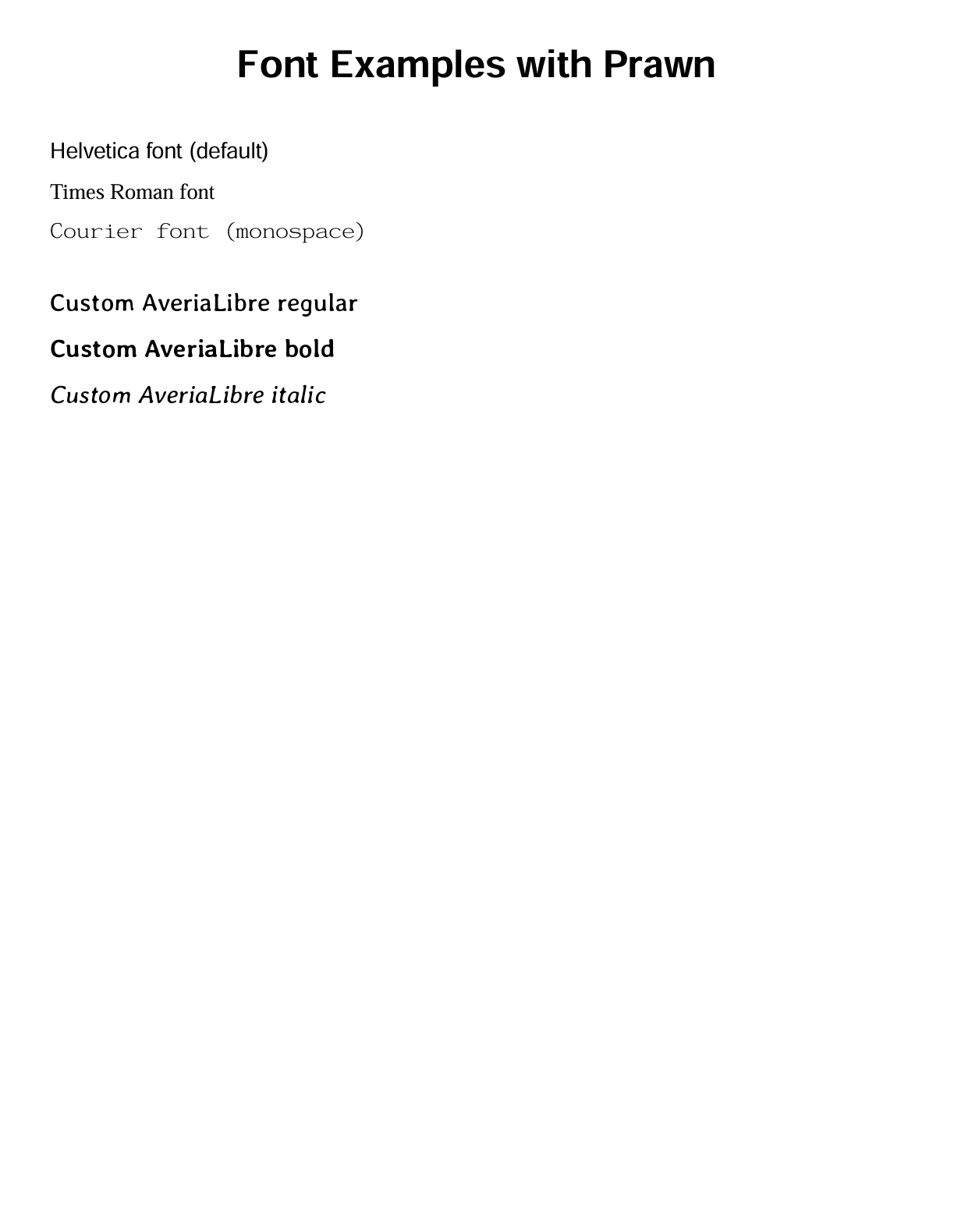
Adding Custom Fonts
To use custom fonts in your Rails application with Prawn:
-
Create the fonts directory:
app/assets/fonts. -
Download free fonts from Google Fonts and add your
TTFfont files:
app/assets/fonts/
├── OpenSans-Regular.ttf
├── OpenSans-Bold.ttf
├── OpenSans-Italic.ttf
└── OpenSans-BoldItalic.ttf
- Register font families in your PDF code:
pdf.font_families.update(
"OpenSans" => {
normal: Rails.root.join("app/assets/fonts/OpenSans-Regular.ttf"),
bold: Rails.root.join("app/assets/fonts/OpenSans-Bold.ttf"),
italic: Rails.root.join("app/assets/fonts/OpenSans-Italic.ttf"),
bold_italic: Rails.root.join("app/assets/fonts/OpenSans-BoldItalic.ttf")
}
)
Prawn supports TrueType (.ttf) fonts. Make sure to download the TTF version when getting fonts from Google Fonts or other sources.
Working with Images in PDFs Using Prawn
Prawn makes it easy to embed images in your PDF documents with flexible positioning and sizing options.
Adding Images to Your PDF
Here's an example demonstrating various image positioning and sizing techniques in Prawn:
Click to view the complete image examples code
# app/controllers/pdfs_controller.rb
class PdfsController < ApplicationController
def generate
pdf = Prawn::Document.new do |pdf|
# Page title
pdf.text "Working with Images in Prawn", size: 24, style: :bold, align: :center
pdf.move_down 40
# Basic image insertion
begin
# Place image files in app/assets/images/
if File.exist?(Rails.root.join("app/assets/images/image.jpg"))
pdf.text "Basic image with fixed width:", size: 14, style: :bold
pdf.image Rails.root.join("app/assets/images/image.jpg"),
at: [50, pdf.cursor - 20],
width: 180
pdf.move_down 200
end
rescue => e
pdf.text "Image not found", size: 12
pdf.move_down 20
end
# Centered image positioning
begin
if File.exist?(Rails.root.join("app/assets/images/image.jpg"))
pdf.text "Centered image:", size: 14, style: :bold
image_width = 150
page_width = pdf.bounds.width
x_position = (page_width - image_width) / 2
pdf.image Rails.root.join("app/assets/images/image.jpg"),
at: [x_position, pdf.cursor - 20],
width: image_width
pdf.move_down 200
end
rescue => e
pdf.text "Image not found", size: 12
pdf.move_down 20
end
# Image scaling example
begin
if File.exist?(Rails.root.join("app/assets/images/image.jpg"))
pdf.text "Scaled image (fit area):", size: 14, style: :bold
pdf.image Rails.root.join("app/assets/images/image.jpg"),
at: [50, pdf.cursor - 20],
fit: [300, 150]
pdf.move_down 120
end
rescue => e
pdf.text "Image not found", size: 12
pdf.move_down 20
end
end
send_data pdf.render,
filename: "image_examples.pdf",
type: "application/pdf",
disposition: "inline"
end
end
Here's the output:
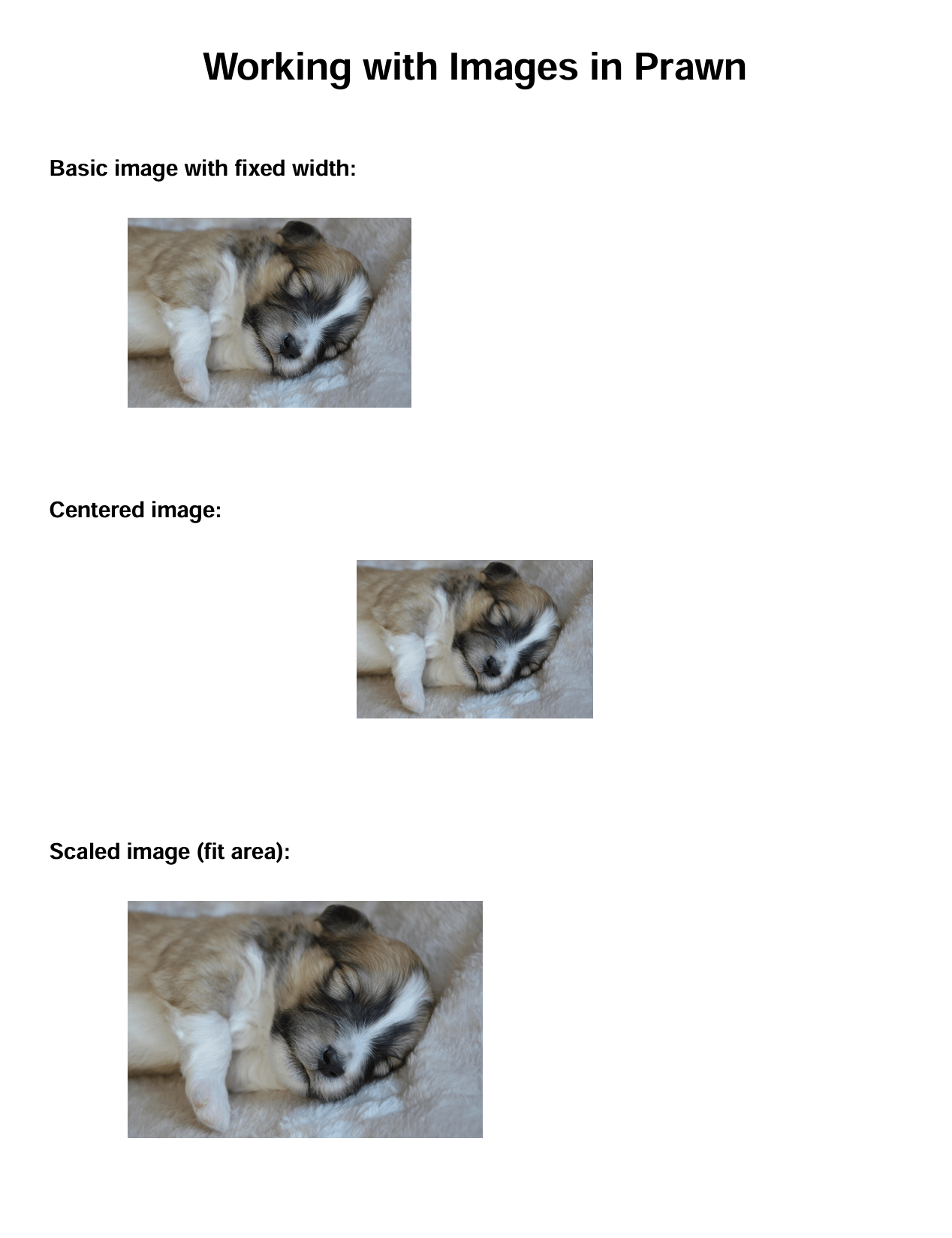
Prawn supports JPEG and PNG images natively. For SVG support, add the prawn-svg gem to your Gemfile.
Image Positioning Options
| Method | Description | Example |
|---|---|---|
at: [x, y] | Position image at specific coordinates | at: [50, 700] |
width: value | Set image width, height scales proportionally | width: 200 |
height: value | Set image height, width scales proportionally | height: 150 |
fit: [w, h] | Scale image to fit within specified area | fit: [300, 200] |
position: :center | Center image horizontally | position: :center |
Working with Tables in PDFs Using Prawn
Tables are essential for displaying structured data in PDFs. Prawn's table functionality provides flexible styling and layout options for creating professional data presentations.
Tables in Prawn require the prawn-table gem. Add gem 'prawn-table' to your Gemfile and run bundle install.
Creating Tables
Here's an example demonstrating basic table creation with headers, styling, and data formatting:
Click to view the complete table examples code
# app/controllers/pdfs_controller.rb
class PdfsController < ApplicationController
def generate
pdf = Prawn::Document.new do |pdf|
# Page title
pdf.text "Table Examples with Prawn", size: 24, style: :bold, align: :center
pdf.move_down 30
# Sample data for our table
table_data = [
["Product", "Quantity", "Price", "Total"],
["Ruby on Rails Tutorial", "1", "$59.99", "$59.99"],
["Rails Performance Guide", "1", "$29.99", "$29.99"],
["Prawn PDF Guide", "1", "$19.99", "$19.99"],
["Code Review Service", "3", "$75.00", "$225.00"],
]
# Basic table
pdf.text "Basic Table:", size: 16, style: :bold
pdf.move_down 10
pdf.table(table_data, header: true, width: pdf.bounds.width) do
# Header styling
row(0).font_style = :bold
row(0).background_color = "E8E8E8"
row(0).text_color = "000000"
# Alternating row colors
(1..row_length-1).each do |i|
row(i).background_color = i.odd? ? "F8F8F8" : "FFFFFF"
end
# Column alignment
columns(1..3).align = :right
columns(0).align = :left
# Cell styling
cells.padding = 8
cells.border_width = 1
cells.border_color = "CCCCCC"
end
end
send_data pdf.render,
filename: "table_examples.pdf",
type: "application/pdf",
disposition: "inline"
end
end
Here's the output:
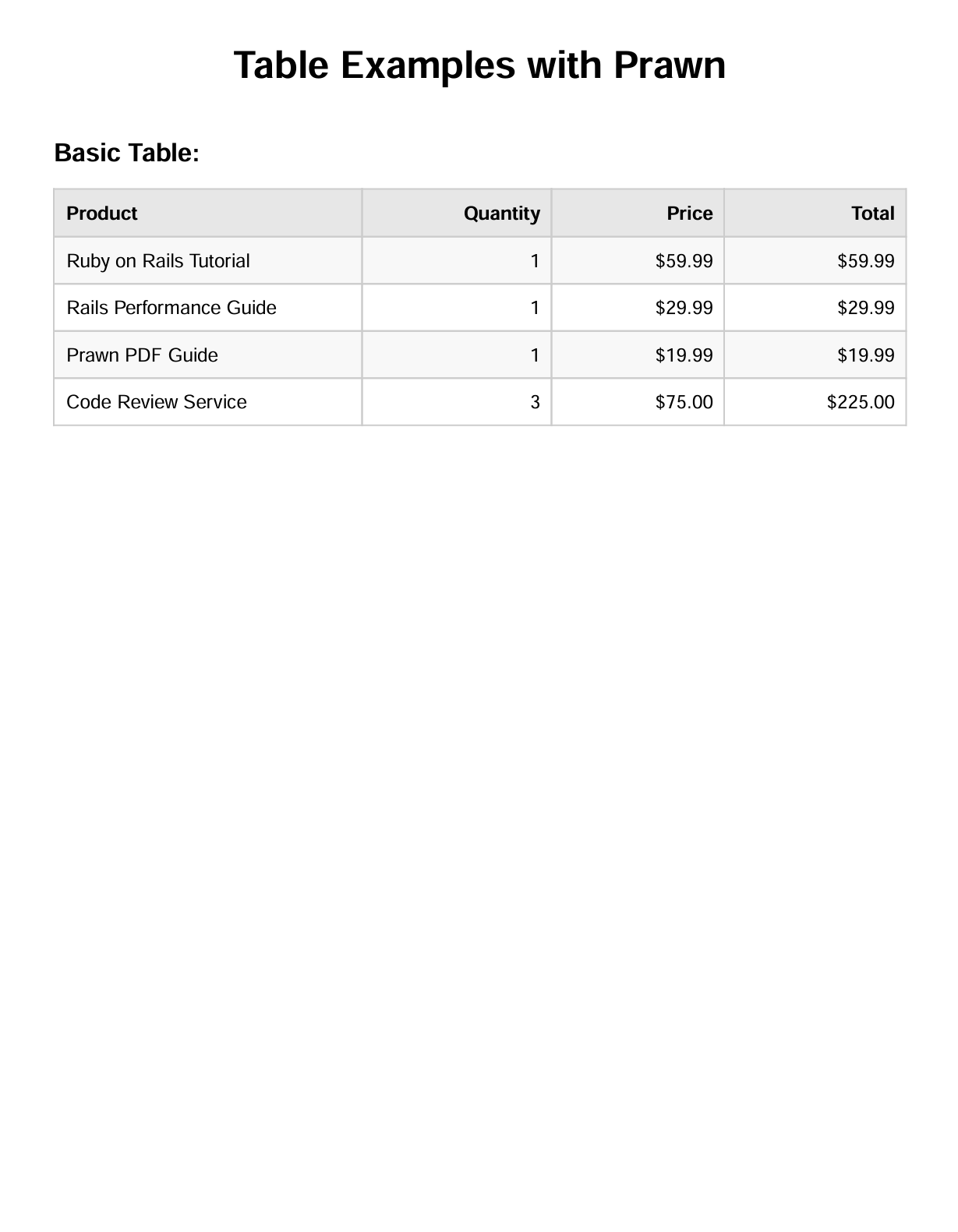
Working with Headers and Footers
Prawn makes it easy to create consistent headers and footers that appear on every page of your document.
Adding Headers and Footers
Here's an example demonstrating how to add repeating headers and footers with page numbering:
Click to view the complete header and footer code
# app/controllers/pdfs_controller.rb
class PdfsController < ApplicationController
def generate
pdf = Prawn::Document.new do |pdf|
# Add header to all pages
pdf.repeat(:all) do
pdf.canvas do
# Header background
pdf.fill_color "2E86AB"
pdf.fill_rectangle [0, pdf.bounds.top], pdf.bounds.width, 40
# Header text
pdf.fill_color "FFFFFF"
pdf.font_size 16
pdf.draw_text "Company Name", at: [20, pdf.bounds.top - 25]
# Reset color
pdf.fill_color "000000"
end
end
# Add footer to all pages
pdf.repeat(:all) do
pdf.canvas do
# Footer line
pdf.stroke_color "CCCCCC"
pdf.line_width 1
pdf.stroke_horizontal_line 0, pdf.bounds.width, at: 30
# Footer text - left side
pdf.fill_color "666666"
pdf.font_size 10
pdf.draw_text "[email protected]", at: [20, 15]
# Reset color
pdf.fill_color "000000"
end
end
# Main content area (with top/bottom margins for header/footer)
pdf.bounding_box([0, pdf.bounds.top - 60], width: pdf.bounds.width, height: pdf.bounds.height - 120) do
# Page title
pdf.text "Multi-Page Document with Headers and Footers", size: 20, style: :bold
pdf.move_down 20
# Generate content for 2 pages
2.times do |i|
pdf.text "Chapter #{i + 1}", size: 24, style: :bold
pdf.move_down 10
# Lorem ipsum content
content = "Lorem ipsum dolor sit amet, consectetur adipiscing elit. Nullam arcu magna, aliquam vitae maximus vitae, consectetur a diam." * 5
pdf.text content, align: :justify
pdf.move_down 20
# Force new page except for last iteration
pdf.start_new_page unless i == 1
end
end
# Add page numbers
pdf.number_pages "Page <page> of <total>",
at: [pdf.bounds.right - 100, 10],
align: :right,
size: 10,
color: "666666"
end
send_data pdf.render,
filename: "header_footer_examples.pdf",
type: "application/pdf",
disposition: "inline"
end
end
Output Preview:
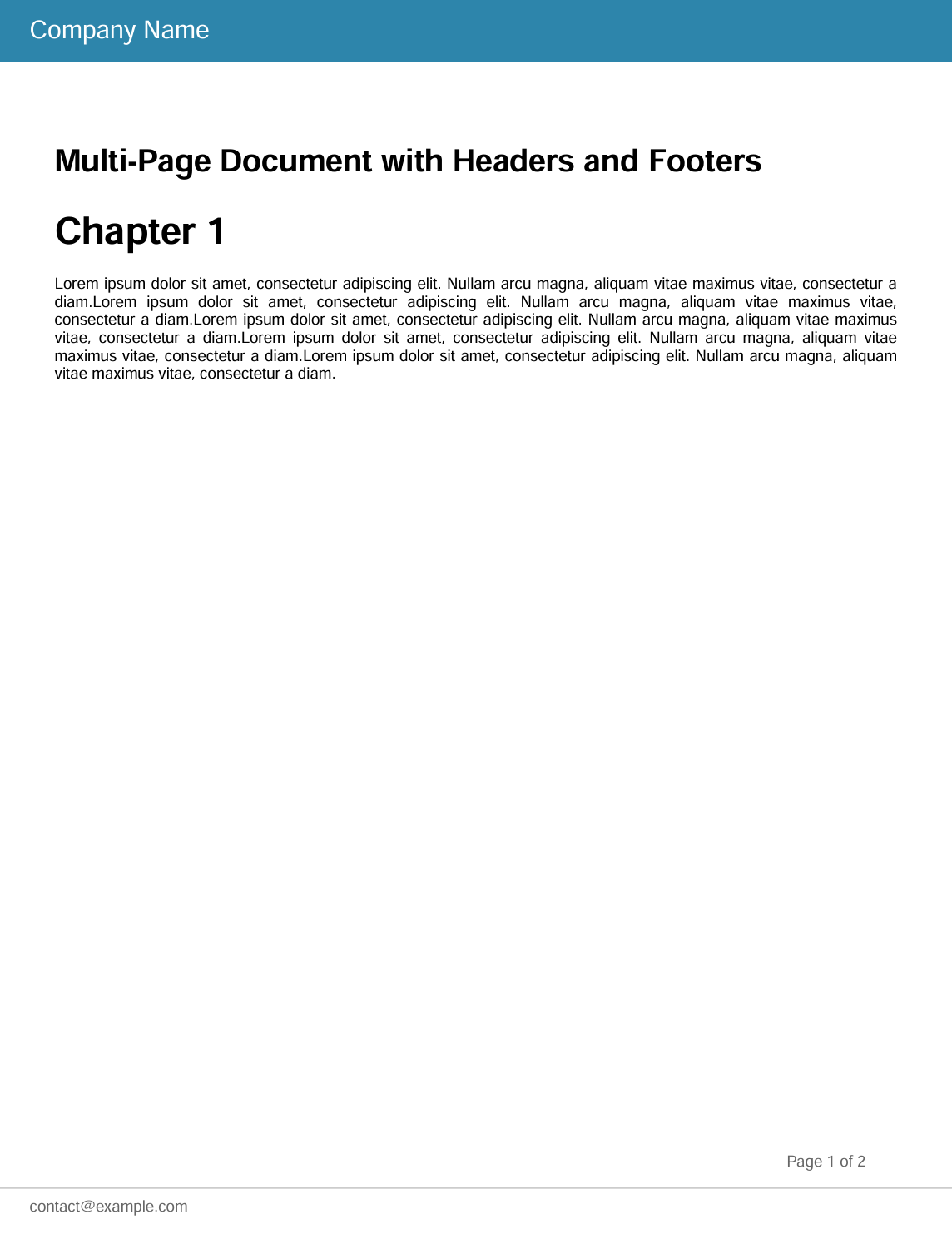
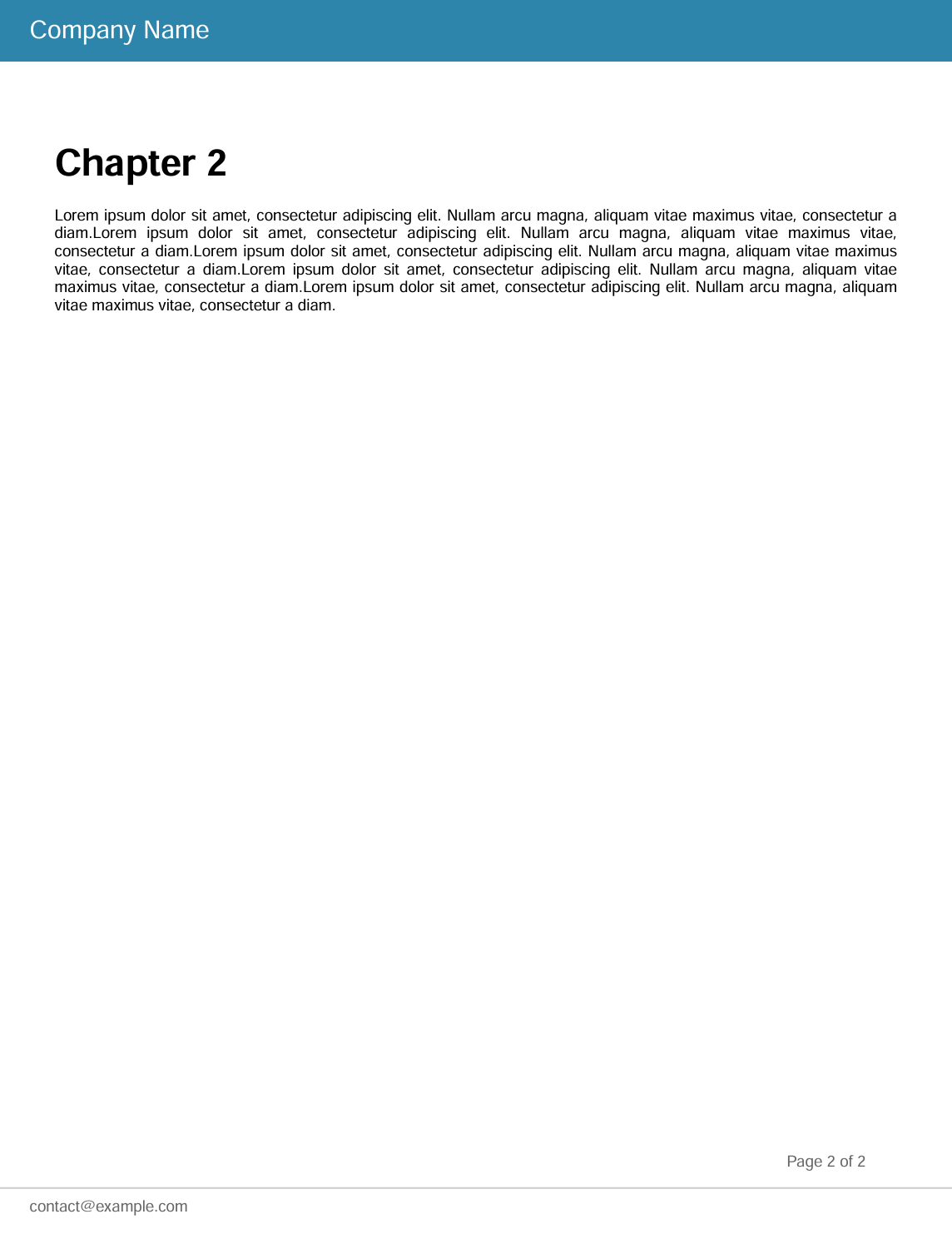
Header and Footer Features
| Feature | Description | Example |
|---|---|---|
pdf.repeat(:all) | Add content to all pages | Headers, footers, watermarks |
pdf.canvas | Draw outside main content flow | Fixed positioning elements |
pdf.number_pages | Add page numbering | "Page 1 of 3" format |
pdf.bounding_box | Create content area with margins | Reserve space for headers/footers |
pdf.start_new_page | Force page breaks | Multi-page documents |
Rails Invoice PDF Generator: Complete Prawn Tutorial
In this example, we'll build a complete invoice generator that showcases Prawn's capabilities in a real business scenario. This example uses sample data without requiring a database.
What we'll build:
- Professional invoice layout with company logo and branding.
- Styled data tables for line items.
- Financial calculations including subtotals, tax, and totals.
- Custom styling with headers, footers, and color schemes.
- Clean Rails architecture using Service Objects for maintainable code.
Before getting started, make sure you have:
prawngemprawn-tablegem for table functionality
Project Structure
Organize your Rails application following conventions with proper separation of concerns.
app/
├── controllers/
│ └── invoices_controller.rb
├── services/
│ └── invoice_pdf_service.rb
└── assets/
└── images/
└── company_logo.png
Step 1: Create the Invoice PDF Service
The service class encapsulates all PDF generation logic, keeping controllers clean and code easily testable.
Click to view the complete invoice PDF service
# app/services/invoice_pdf_service.rb
class InvoicePdfService
def initialize(invoice_data)
@invoice = invoice_data
# Auto-generate invoice number if not provided
@invoice[:number] ||= generate_invoice_number
end
def generate
Prawn::Document.new(margin: 40) do |pdf|
add_header(pdf)
add_company_and_client_info(pdf)
add_line_items_table(pdf)
add_totals_section(pdf)
add_payment_info(pdf)
add_footer(pdf)
end
end
private
# Generate invoice number based on current year, month and random number
def generate_invoice_number
current_time = Time.current
year = current_time.strftime("%y")
month = current_time.strftime("%m")
random_number = rand(100..999)
"INV-#{year}#{month}-#{random_number}"
end
# Add header with company logo, invoice title and details
def add_header(pdf)
pdf.repeat(:all) do
pdf.canvas do
pdf.fill_color "e0eaf9"
pdf.fill_rectangle [0, pdf.bounds.top], pdf.bounds.width, 130
# Company logo placement (optional)
begin
if File.exist?(Rails.root.join("app/assets/images/company_logo.png"))
pdf.image Rails.root.join("app/assets/images/company_logo.png"),
at: [30, pdf.bounds.top - 20],
width: 70
end
rescue
# Continue without logo if file not found
end
# Invoice title
pdf.fill_color "000000"
pdf.font_size 32
pdf.font "Helvetica", style: :bold
pdf.draw_text "INVOICE", at: [pdf.bounds.width - 200, pdf.bounds.top - 50]
# Invoice details
pdf.font "Helvetica", style: :normal
pdf.font_size 11
details_y = pdf.bounds.top - 75
pdf.draw_text "Invoice Number: #{@invoice[:number]}", at: [pdf.bounds.width - 200, details_y]
pdf.draw_text "Issue Date: #{@invoice[:issue_date]}", at: [pdf.bounds.width - 200, details_y - 15]
pdf.draw_text "Due Date: #{@invoice[:due_date]}", at: [pdf.bounds.width - 200, details_y - 30]
end
end
end
# Add company and client billing information
def add_company_and_client_info(pdf)
pdf.move_down 130
# Company information
pdf.font "Helvetica", style: :bold
pdf.text "BILL FROM:", size: 13
pdf.move_down 5
pdf.font "Helvetica", style: :normal
pdf.text_box company_info_text,
at: [0, pdf.cursor],
width: 250,
size: 11,
leading: 5
# Client information
pdf.font "Helvetica", style: :bold
bill_to_y = pdf.cursor + 10
pdf.draw_text "BILL TO:", at: [300, bill_to_y], size: 13
pdf.font "Helvetica", style: :normal
pdf.text_box client_info_text,
at: [300, bill_to_y - 10],
width: 250,
size: 11,
leading: 5
pdf.move_down 120
end
# Create table
def add_line_items_table(pdf)
# Build table data with headers
table_data = [["Description", "Quantity", "Price", "Total"]]
# Add each line item to table
@invoice[:line_items].each do |item|
table_data << [
item[:description],
item[:quantity].to_s,
"$#{sprintf('%.2f', item[:price])}",
"$#{sprintf('%.2f', item[:quantity] * item[:price])}"
]
end
# Create table with styling
pdf.table(table_data,
header: true,
width: pdf.bounds.width) do
# Header row styling
row(0).background_color = "E9ECEF"
row(0).font_style = :bold
row(0).height = 30
# Alternating row colors for readability
(1..row_length - 1).each do |i|
row(i).background_color = i.odd? ? "F8F9FA" : "FFFFFF"
end
# General cell styling
cells.padding = [8, 8]
cells.border_width = 1
cells.border_color = "E9ECEF"
cells.size = 11
columns(1..3).align = :right
columns(0).align = :left
end
pdf.move_down 15
end
# Add totals section with subtotal, tax, and final total
def add_totals_section(pdf)
# Calculate financial totals
subtotal = calculate_subtotal
tax = subtotal * @invoice[:tax_rate]
total = subtotal + tax
# Build totals table data
totals_data = [
["Subtotal:", "$#{sprintf('%.2f', subtotal)}"],
["Tax (#{(@invoice[:tax_rate] * 100).round(1)}%):", "$#{sprintf('%.2f', tax)}"],
["Total:", "$#{sprintf('%.2f', total)}"]
]
# Totals table
pdf.table(totals_data,
position: :right,
width: 200,
column_widths: [120, 80]) do
cells.border_width = 0
cells.padding = [8, 8]
cells.size = 11
columns(1).align = :right
# Total row
row(-1).font_style = :bold
row(-1).size = 13
row(-1).background_color = "F8F9FA"
row(-1).border_top_width = 1
row(-1).border_top_color = "64A7F0"
end
pdf.move_down 25
end
# Add payment instructions and notes
def add_payment_info(pdf)
pdf.text "Payment Information", size: 13, style: :bold
pdf.move_down 8
# Extract payment details from invoice data
bank_name = @invoice[:payment_info]&.[](:bank_name)
account_number = @invoice[:payment_info]&.[](:account_number)
routing_number = @invoice[:payment_info]&.[](:routing_number)
payment_terms = @invoice[:payment_info]&.[](:terms)
# Format payment information
payment_text = [
"Bank: #{bank_name}",
"Account: #{account_number}",
"Routing: #{routing_number}",
"Payment Terms: #{payment_terms}"
].join("\n")
pdf.text payment_text, size: 10, leading: 5
# Add optional notes section
if @invoice[:notes]
pdf.move_down 15
pdf.text "Notes:", size: 13, style: :bold
pdf.move_down 4
pdf.text @invoice[:notes], size: 10, leading: 5
end
end
# Add footer
def add_footer(pdf)
pdf.repeat(:all) do
pdf.canvas do
# Horizontal separator line
pdf.stroke_color "CCCCCC"
pdf.line_width 1
pdf.stroke_horizontal_line 0, pdf.bounds.width, at: 30
pdf.fill_color "666666"
pdf.font_size 10
footer_text = "Thank you for your business!"
text_width = pdf.width_of(footer_text, size: 10)
x_position = (pdf.bounds.width - text_width) / 2
pdf.draw_text footer_text, at: [x_position, 15]
end
end
end
# Format company information for display
def company_info_text
company = @invoice[:company]
[
company[:name],
company[:address],
"#{company[:city]}, #{company[:state]} #{company[:zip]}",
company[:phone],
company[:email]
].join("\n")
end
# Format client information for display
def client_info_text
client = @invoice[:client]
[
client[:name],
client[:address],
"#{client[:city]}, #{client[:state]} #{client[:zip]}",
client[:phone],
client[:email]
].join("\n")
end
# Calculate subtotal from all line items
def calculate_subtotal
@invoice[:line_items].sum { |item| item[:quantity] * item[:price] }
end
end
This service handles everything from invoice number generation to professional styling for complete business invoice functionality.
Step 2: Create the Controller with Sample Data
This controller provides a complete working example with sample data.
Click to view the controller implementation
# app/controllers/invoices_controller.rb
class InvoicesController < ApplicationController
def generate_invoice
# Sample invoice data - invoice number will be auto-generated
invoice_data = {
issue_date: "May 28, 2025",
due_date: "June 27, 2025",
tax_rate: 0.08,
company: {
name: "Go Company Solutions",
address: "123 Innovation Drive",
city: "Metropolis",
state: "CA",
zip: "10001",
phone: "(555) 123-4567",
email: "[email protected]"
},
client: {
name: "Startup Inc.",
address: "456 Market Street",
city: "Centerville",
state: "NY",
zip: "10002",
phone: "(000) 333-4444",
email: "[email protected]"
},
line_items: [
{
description: "Ruby on Rails Development",
quantity: 40,
price: 150.00
},
{
description: "Database Design and Setup",
quantity: 8,
price: 200.00
},
{
description: "API Integration",
quantity: 12,
price: 175.00
},
{
description: "Quality Assurance",
quantity: 16,
price: 125.00
}
],
payment_info: {
bank_name: "Generic Bank",
account_number: "30000123456",
routing_number: "111122223",
terms: "Net 30"
},
notes: "Payment due within 30 days. Please include the invoice number with your payment."
}
# Generate PDF with auto-generated invoice number
pdf_service = InvoicePdfService.new(invoice_data)
pdf_data = pdf_service.generate.render
# Get the generated invoice number for filename
generated_number = invoice_data[:number].gsub(/[^0-9A-Za-z]/, '_')
send_data pdf_data,
filename: "invoice_#{generated_number}.pdf",
type: "application/pdf",
disposition: "inline"
end
end
Step 3: Configuring Rails Routes for PDF Generation
Adding Invoice PDF Routes:
# config/routes.rb
Rails.application.routes.draw do
get 'generate_invoice', to: 'invoices#generate_invoice'
end
Step 4: Testing Your Invoice Generator
Test your invoice generator by navigating to:
http://127.0.0.1:3000/generate_invoice
Here's the invoice output:

Key Features Demonstrated
- Service Object Pattern – Clean separation of concerns with dedicated PDF logic.
- Professional Styling – Headers, footers, company branding.
- Complete Invoice Layout – Company info, client details, line items, totals.
- Error Handling – Graceful fallbacks for missing fonts/images.
- Business Calculations – Subtotal, tax, and total calculations.
- Rails Best Practices – Proper MVC organization following Rails conventions.
PDF Generation Best Practices
Following these proven practices will help you build robust, scalable PDF generation systems in your Rails applications.
| Practice | Description |
|---|---|
| Service Object Pattern | Isolate PDF logic in dedicated service classes for better maintainability. |
| Performance Optimization | Use background jobs for heavy generation and batch processing for large datasets. |
| Font Management | Use standard PDF fonts when possible and implement fallback fonts. |
| Error Handling | Gracefully handle missing fonts, images, and invalid data with meaningful fallbacks. |
| Template Reusability | Create modular methods for headers, footers, and common elements. |
| Image Optimization | Resize and compress images before embedding in PDF. |
| Content Validation | Validate/sanitize user data before PDF generation to prevent errors. |
| Security Measures | Sanitize file paths and validate image sources to prevent security vulnerabilities. |
HTML to PDF Conversion Alternatives for Ruby on Rails
While Prawn excels at programmatic PDF generation, you might need HTML to PDF conversion for certain use cases. Here are the recommended approaches for Rails applications:
| Approach | Tools | Best For | Learn More |
|---|---|---|---|
| Browser Automation | Ferrum | Complex web pages with JavaScript and CSS. | Ferrum gem |
| Headless Chrome | Grover | High-fidelity HTML rendering with modern CSS support. | Grover gem |
| wkhtmltopdf Integration | WickedPDF | Established HTML to PDF solution with Rails integration. | HTML to PDF with WickedPDF |
| HTML to PDF APIs | PDFBolt | Production-ready conversion with complex layouts. | HTML to PDF API Docs |
| HTML Parsing | Nokogiri + Prawn | Converting simple HTML to Prawn elements. | Nokogiri documentation |
Conclusion
Prawn stands out as a powerful and flexible solution for PDF generation in Ruby on Rails applications. Its pure Ruby implementation, combined with an intuitive API and comprehensive feature set, makes it an excellent choice for creating professional PDF documents that integrate seamlessly with Rails.
This comprehensive Ruby on Rails PDF tutorial demonstrates how Prawn handles everything from simple text documents to complex business invoices with precise control over layout, typography, and visual design. Whether you're building automated invoice generation systems, generating financial reports in Rails, creating certificates, or developing document automation workflows, Prawn provides the solutions and flexibility needed for production-ready PDF applications.
For Ruby developers looking for programmatic PDF creation, Prawn offers superior maintainability and performance with full control over document structure and styling. When you need to convert HTML to PDF, consider specialized solutions like browser automation tools or dedicated HTML to PDF API services.
Prawn for PDFs, prawns for dinner. That’s real full-stack. 🦐
